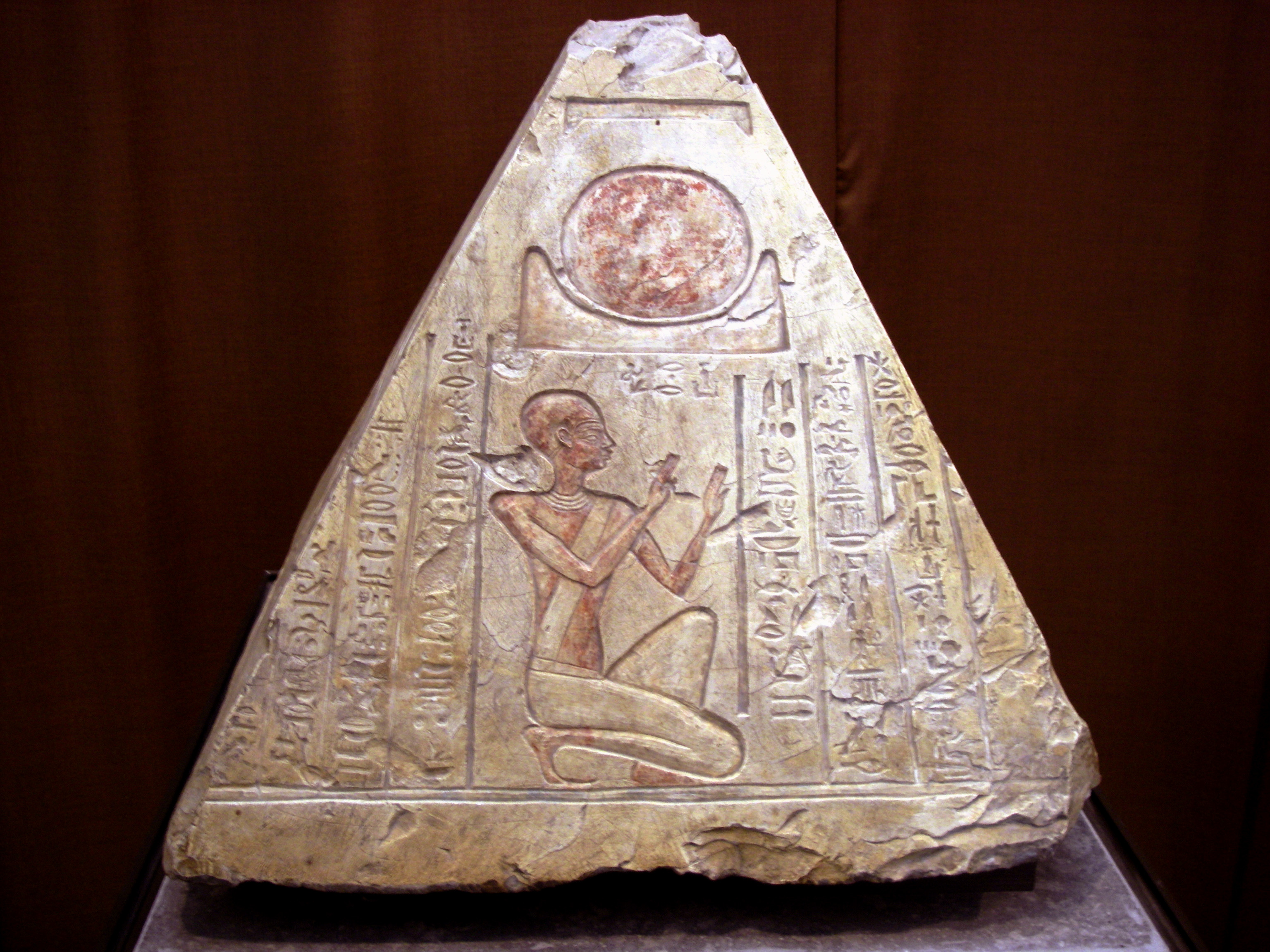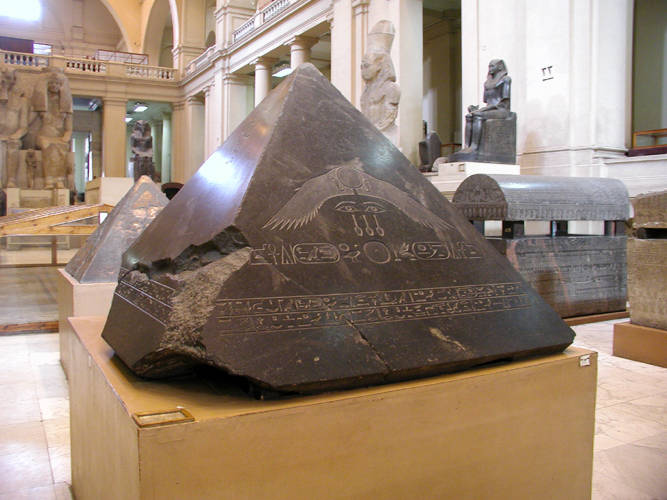Pyramidion on:
[Wikipedia]
[Google]
[Amazon]

 A pyramidion (plural: pyramidia) is the uppermost piece or capstone of an
A pyramidion (plural: pyramidia) is the uppermost piece or capstone of an
File:Pyramidion of Nesnubhotep, top of a limestone chapel monument. A scarab and adoring baboons in relief. 26th Dynasty. From Abydos, Egypt. The Petrie Museum of Egyptian Archaeology, London.jpg, Pyramidion of Nesnubhotep, top of a limestone chapel monument. A scarab and adoring baboons in relief. 26th Dynasty. From Abydos, Egypt. The Petrie Museum of Egyptian Archaeology, London
File:Pyramidion of Nebamun. Possibly top of a stela. Limestone. 19th Dynasty. From Egypt. Bought in the Thebaid (Thebais) but probably it came from Deir el-Medina. The Petrie Museum of Egyptian Archaeology, London.jpg, Pyramidion of Nebamun. Possibly top of a stela. Limestone. 19th Dynasty. From Egypt. Bought in the Thebaid (Thebais) but probably it came from Deir el-Medina. The Petrie Museum of Egyptian Archaeology, London (UC14574)
File:PyramidionFromPrivateTomb RosicrucianMuseum.png, Private tomb pyramidion made of limestone, at the

 A pyramidion (plural: pyramidia) is the uppermost piece or capstone of an
A pyramidion (plural: pyramidia) is the uppermost piece or capstone of an Egyptian pyramid
The Egyptian pyramids are ancient masonry structures located in Egypt. Sources cite at least 118 identified "Egyptian" pyramids. Approximately 80 pyramids were built within the Kingdom of Kush, now located in the modern country of Sudan. O ...
or obelisk
An obelisk (; from grc, ὀβελίσκος ; diminutive of ''obelos'', " spit, nail, pointed pillar") is a tall, four-sided, narrow tapering monument which ends in a pyramid-like shape or pyramidion at the top. Originally constructed by An ...
. Speakers of the Ancient Egyptian language
The Egyptian language or Ancient Egyptian ( ) is a dead Afro-Asiatic language that was spoken in ancient Egypt. It is known today from a large corpus of surviving texts which were made accessible to the modern world following the deciphe ...
referred to pyramidia as ''benbenet'' and associated the pyramid as a whole with the sacred benben stone.Toby Wilkinson, ''The Thames and Hudson Dictionary of Ancient Egypt'', Thames & Hudson, 2005. p. 197 During Egypt's Old Kingdom
In ancient Egyptian history, the Old Kingdom is the period spanning c. 2700–2200 BC. It is also known as the "Age of the Pyramids" or the "Age of the Pyramid Builders", as it encompasses the reigns of the great pyramid-builders of the Fourth ...
, pyramidia were generally made of diorite
Diorite ( ) is an intrusive igneous rock formed by the slow cooling underground of magma (molten rock) that has a moderate content of silica and a relatively low content of alkali metals. It is intermediate in composition between low-sil ...
, granite
Granite () is a coarse-grained ( phaneritic) intrusive igneous rock composed mostly of quartz, alkali feldspar, and plagioclase. It forms from magma with a high content of silica and alkali metal oxides that slowly cools and solidifies un ...
, or fine limestone
Limestone ( calcium carbonate ) is a type of carbonate sedimentary rock which is the main source of the material lime. It is composed mostly of the minerals calcite and aragonite, which are different crystal forms of . Limestone forms w ...
, then covered in gold
Gold is a chemical element with the symbol Au (from la, aurum) and atomic number 79. This makes it one of the higher atomic number elements that occur naturally. It is a bright, slightly orange-yellow, dense, soft, malleable, and ductile ...
or electrum
Electrum is a naturally occurring alloy of gold and silver, with trace amounts of copper and other metals. Its color ranges from pale to bright yellow, depending on the proportions of gold and silver. It has been produced artificially, and ...
; during the Middle Kingdom and through the end of the pyramid-building era, they were built from granite
Granite () is a coarse-grained ( phaneritic) intrusive igneous rock composed mostly of quartz, alkali feldspar, and plagioclase. It forms from magma with a high content of silica and alkali metal oxides that slowly cools and solidifies un ...
. A pyramidion was "covered in gold leaf
Gold leaf is gold that has been hammered into thin sheets (usually around 0.1 µm thick) by goldbeating and is often used for gilding. Gold leaf is available in a wide variety of karats and shades. The most commonly used gold is 22-kara ...
to reflect the rays of the sun"; during Egypt's Middle Kingdom pyramidia were often "inscribed with royal titles and religious symbols".
Very few pyramidia have survived into modern times. Most of those that remain are made of polished black granite, inscribed with the name of the pyramid's owner. Four pyramidia – the world's largest collection – are housed in the main hall of the Egyptian Museum
The Museum of Egyptian Antiquities, known commonly as the Egyptian Museum or the Cairo Museum, in Cairo, Egypt, is home to an extensive collection of ancient Egyptian antiquities. It has 120,000 items, with a representative amount on display a ...
in Cairo
Cairo ( ; ar, القاهرة, al-Qāhirah, ) is the capital of Egypt and its largest city, home to 10 million people. It is also part of the largest urban agglomeration in Africa, the Arab world and the Middle East: The Greater Cairo metr ...
. Among them are the pyramidia from the so-called Black Pyramid
The Black Pyramid ( ar, الهرم الأسود, al-Haram al'Aswad) was built by King Amenemhat III (r. c. 1860 BC-c. 1814 BC) during the Middle Kingdom of Egypt (2055–1650 BC). It is one of the five remaining pyramids of the original eleven ...
of Amenemhat III
:''See Amenemhat, for other individuals with this name.''
Amenemhat III ( Ancient Egyptian: ''Ỉmn-m-hꜣt'' meaning 'Amun is at the forefront'), also known as Amenemhet III, was a pharaoh of ancient Egypt and the sixth king of the Twelfth D ...
at Dahshur
DahshurAlso transliterated ''Dahshour'' (in English often called ''Dashur'' ar, دهشور ' , ''Dahchur'') is a royal necropolis located in the desert on the west bank of the Nile approximately south of Cairo. It is known chiefly for several p ...
and of the Pyramid of Khendjer at Saqqara
Saqqara ( ar, سقارة, ), also spelled Sakkara or Saccara in English , is an Egyptian village in Giza Governorate, that contains ancient burial grounds of Egyptian royalty, serving as the necropolis for the ancient Egyptian capital, Memph ...
.editors Regine Schulz and Matthias Seidel (w/34 contributing Authors), ''Egypt, The World of the Pharaohs,'' Konemann, Germany: 1998. ''Amenemhat III
:''See Amenemhat, for other individuals with this name.''
Amenemhat III ( Ancient Egyptian: ''Ỉmn-m-hꜣt'' meaning 'Amun is at the forefront'), also known as Amenemhet III, was a pharaoh of ancient Egypt and the sixth king of the Twelfth D ...
'', 1842–1797 BC
A badly damaged white Tura limestone pyramidion, thought to have been made for the Red Pyramid
The Red Pyramid, also called the North Pyramid, is the largest of the pyramids located at the Dahshur necropolis in Cairo, Egypt. Named for the rusty reddish hue of its red limestone stones, it is also the third largest Egyptian pyramid, after t ...
of Sneferu
Sneferu ( snfr-wj "He has perfected me", from ''Ḥr-nb-mꜣꜥt-snfr-wj'' "Horus, Lord of Maat, has perfected me", also read Snefru or Snofru), well known under his Hellenized name Soris ( grc-koi, Σῶρις by Manetho), was the founding phar ...
at Dahshur, has been reconstructed and is on open-air display beside that pyramid; it presents a minor mystery, however, as its angle of inclination is steeper than that of the edifice it was apparently built to surmount.
Private brick pyramids with pyramidia
During theNew Kingdom
New is an adjective referring to something recently made, discovered, or created.
New or NEW may refer to:
Music
* New, singer of K-pop group The Boyz
Albums and EPs
* ''New'' (album), by Paul McCartney, 2013
* ''New'' (EP), by Regurgitator ...
, some private underground tombs were marked on the surface by small brick pyramids that terminated in pyramidia. The four lateral sides included texts and scenes related to the cult of the Sun God (as the representation of Pharaoh
Pharaoh (, ; Egyptian: '' pr ꜥꜣ''; cop, , Pǝrro; Biblical Hebrew: ''Parʿō'') is the vernacular term often used by modern authors for the kings of ancient Egypt who ruled as monarchs from the First Dynasty (c. 3150 BC) until th ...
).
The scenes typically depict the course of the sun, rising on one lateral face, setting on the opposite face, and traveling, through the night, through the underworld, ruled by Osiris
Osiris (, from Egyptian ''wsjr'', cop, ⲟⲩⲥⲓⲣⲉ , ; Phoenician: 𐤀𐤎𐤓, romanized: ʾsr) is the god of fertility, agriculture, the afterlife, the dead, resurrection, life, and vegetation in ancient Egyptian religion. He wa ...
.
Scribe Mose pyramidion
The pyramidion of Mose ( mes,s, New Kingdom, 19th Dynasty, c. 1250 BC, ''limestone'', 53 cm tall) depicts himself making an offering, with his name on two opposite faces. The adjacent opposite faces feature a baboon: "Screeching upon the rising of the Sun, and the Day". (The baboon is also the god-scribe representation of theScribe
A scribe is a person who serves as a professional copyist, especially one who made copies of manuscripts before the invention of automatic printing.
The profession of the scribe, previously widespread across cultures, lost most of its promi ...
, for the god Thoth
Thoth (; from grc-koi, Θώθ ''Thṓth'', borrowed from cop, Ⲑⲱⲟⲩⲧ ''Thōout'', Egyptian: ', the reflex of " eis like the Ibis") is an ancient Egyptian deity. In art, he was often depicted as a man with the head of an ibis or ...
.)Peck, William. ''Splendors of Ancient Egypt,'' William H. Peck, The Detroit Institute of Arts, (University Lithoprinters Inc., Ann Arbor, Mich.), c. 1997, (p. 67). (''Moses Pyramidion'' from "Roemer and Pelizaeus Museum, Hildesheim, Germany".)
Ptahemwia pyramidion
The pyramidion ofPtahemwia
Ptahemwia or Ptah-em-Wia (Ptah in the barque) was an Ancient Egyptian official who lived under king Ramses II in the 19th Dynasty, around 1250 BC.
Ptahemwia had several titles, providing evidence for his positions mainly at the Ramesseum
The ...
(19th Dynasty, Ramesside Period, c. 1200 BC, ''limestone'', 28 cm wide, 42 cm tall) likewise displays sun-related scenes. The Sun God, Re-Horakhti, and the god of the Underworld, Osiris
Osiris (, from Egyptian ''wsjr'', cop, ⲟⲩⲥⲓⲣⲉ , ; Phoenician: 𐤀𐤎𐤓, romanized: ʾsr) is the god of fertility, agriculture, the afterlife, the dead, resurrection, life, and vegetation in ancient Egyptian religion. He wa ...
, are shown on one lateral face.
Facing the two gods, on the adjacent lateral face, is the deceased Ptahemwia, standing in an offering pose, facing three columns of hieroglyphs.
Gallery
Rosicrucian Egyptian Museum
The Rosicrucian Egyptian Museum (REM) is devoted to ancient Egypt, located at Rosicrucian Park in the Rose Garden neighborhood of San Jose, California, United States.
It was founded by the Ancient Mystical Order Rosae Crucis (AMORC). The Rosi ...
File:Restoration Project at the Red Pyramid in Dahshur.jpg, The restored pyramidion of the Red Pyramid
The Red Pyramid, also called the North Pyramid, is the largest of the pyramids located at the Dahshur necropolis in Cairo, Egypt. Named for the rusty reddish hue of its red limestone stones, it is also the third largest Egyptian pyramid, after t ...
at Dashur, on display beside the pyramid
See also
*Washington Monument
The Washington Monument is an obelisk shaped building within the National Mall in Washington, D.C., built to commemorate George Washington, once commander-in-chief of the Continental Army (1775–1784) in the American Revolutionary War and ...
, which has a solid aluminum pyramidion that serves as a lightning rod
References
External links
{{Authority control Ancient Egyptian pyramids Architectural elements Egyptian artefact types Sacred rocks